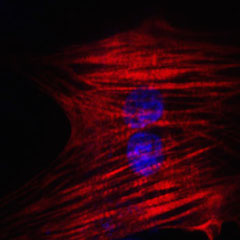In a major breakthrough, scientists at the Gladstone Institutes transformed skin cells into heart cells and brain cells using a combination of chemicals. All previous work on cellular reprogramming required adding external genes to the cells, making this accomplishment an unprecedented feat. The research lays the groundwork for one day being able to regenerate lost or damaged cells with pharmaceutical drugs.
In two studies published in Science and Cell Stem Cell, the team of scientists, who were led by Gladstone senior investigator Sheng Ding, PhD, and are part of the Roddenberry Center for Stem Cell Biology and Medicine at Gladstone, used chemical cocktails to gradually coax skin cells to change into organ-specific stem cell-like cells and, ultimately, into heart or brain cells. This discovery offers a more efficient and reliable method to reprogram cells and avoids medical concerns surrounding genetic engineering.
“This method brings us closer to being able to generate new cells at the site of injury in patients,” said Ding, the senior author on both studies. “Our hope is to one day treat diseases like heart failure or Parkinson’s disease with drugs that help the heart and brain regenerate damaged areas from their own existing tissue cells. This process is much closer to the natural regeneration that happens in animals like newts and salamanders, which has long fascinated us.”

A human heart cell that was chemically reprogrammed from a human skin cell. [Image: Nan Cao, PhD, Gladstone Institutes]
Chemically Repaired Hearts
Adult hearts have a very limited ability to generate new cells, so scientists have searched for a way to replace cells lost after a heart attack, such as transplanting adult heart cells or stem cells into the damaged heart. However, these efforts have been largely ineffective, as most transplanted adult cells do not survive or integrate properly into the heart, and few stem cells can be coaxed into becoming heart cells. An alternative approach pioneered by Deepak Srivastava, MD, director of cardiovascular and stem cell research at Gladstone, used genes to convert scar-forming cells in the heart of animals into new muscle that improved the function of the heart. A chemical reprogramming approach to do the same may offer an easier way to provide the cues that induce heart muscle to regenerate locally.
Read More – Source: Scientists Turn Skin Cells into Heart Cells and Brain Cells Using Drugs | Gladstone Institutes